What’s the Best Cardamom Substitute? Here are 7 Close Seconds for When You’re in a Pinch
Need a cardamom substitute? Here are 7 common spices with warming, spicy, sharp, zesty, or earthy flavor profiles that can mimic cardamom’s unique flavor.
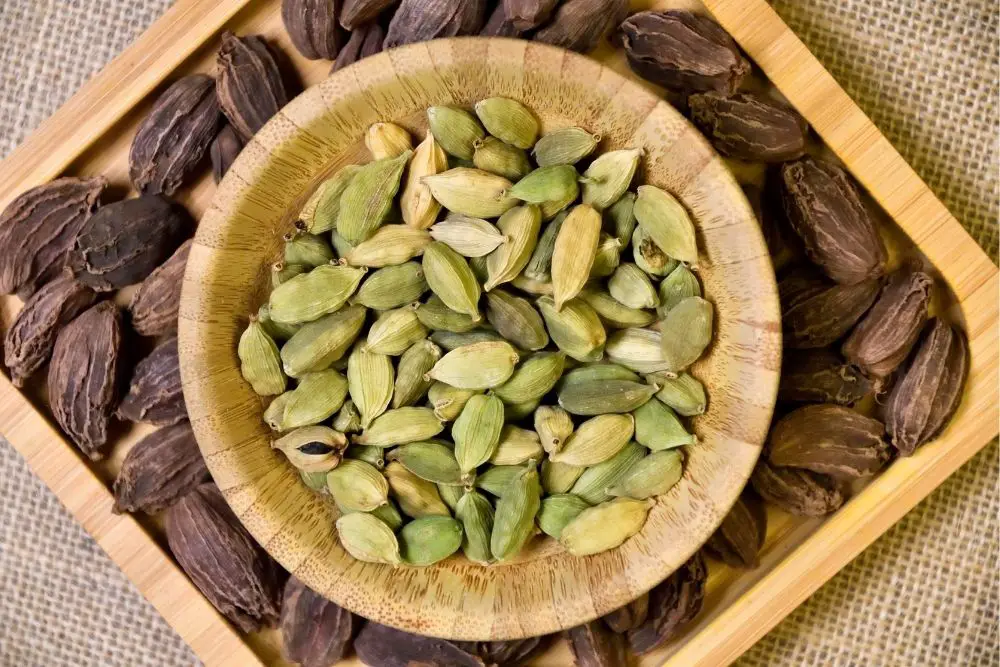
A recipe you’re making calls for cardamom, and you’ve got zilch. So, what can you use in place of cardamom that won’t drastically alter the taste of your dish?
Regarding the best cardamom substitute, I’ve compiled a few combinations of common, inexpensive spices that can mimic the taste. Most of them are easy to find at your local grocery store. Plus, with cardamom being one of the most expensive spices in the world (next to saffron and vanilla bean), it also doesn’t hurt to try these combinations if you’re mindful of your budget.
Before we discuss the best cardamom substitutes, it is helpful to understand the flavor profile and various dishes in which cardamom is used so that you can choose the right substitute for your sweet or savory recipes.
What Is Cardamom?
Cardamom is a pungent, complex spice used widely in Indian and Arabic cuisine. It is used in sweet and savory dishes, such as puddings, chai, lentil stews, curry chicken, and red meat and seafood dishes. In its whole form, cardamom is found in green, black, or white pods, or you can buy it ground.
At first glance, cardamom pods and seeds resemble almonds and miniature pumpkin seeds. Cardamom belongs to the turmeric and ginger family, spices known for their “bite” and sharp, spicy flavor profiles and warming properties.
Cardamom has Egyptian and Southern Indian roots and is used liberally in Middle Eastern and Indian cooking. The history of cardamom dates back to ancient Egypt, where cardamom pods were used as pseudo-breath mints and natural oral care! In fact, cardamom is still used in many parts of the world today to freshen breath. You’ll even find it included in some brands of chewing gum. Studies have also confirmed the health benefits of cardamom, showing that this unique spice is a natural antiseptic and can kill the oral bacteria that cause gingivitis, cavities, and bad breath. A little more bang for your buck in recipes!
How Do You Describe the Flavor of Cardamom (and What Dishes Is It Used In?)
Cardamom has a unique flavor unlike any other spice. In general, it is described as potent, sharp, sweet, ashy, spicy, warming, and aromatic. Due to its strength, a little goes a long way. Cardamom comes in different varieties: green, white, and black, and in whole or powder form.
When it comes to the powder versus the whole spice, whole cardamom seeds and pods will always taste stronger than the ground spice, which loses some of its pungency after grinding. If you happen to have cardamom powder on hand, note that it can be ideal for lighter dishes where you don’t want to create an overpowering flavor, such as desserts and baked goods.
Note that each variety of cardamom tastes different, so it helps to understand how each type varies so that you know which cardamom replacement is most appropriate for your dish.
Green Cardamom vs. Black Cardamom vs. White Cardamom: Why Knowing the Three Different Types of Cardamom Matters
What Does Green Cardamom Taste Like?
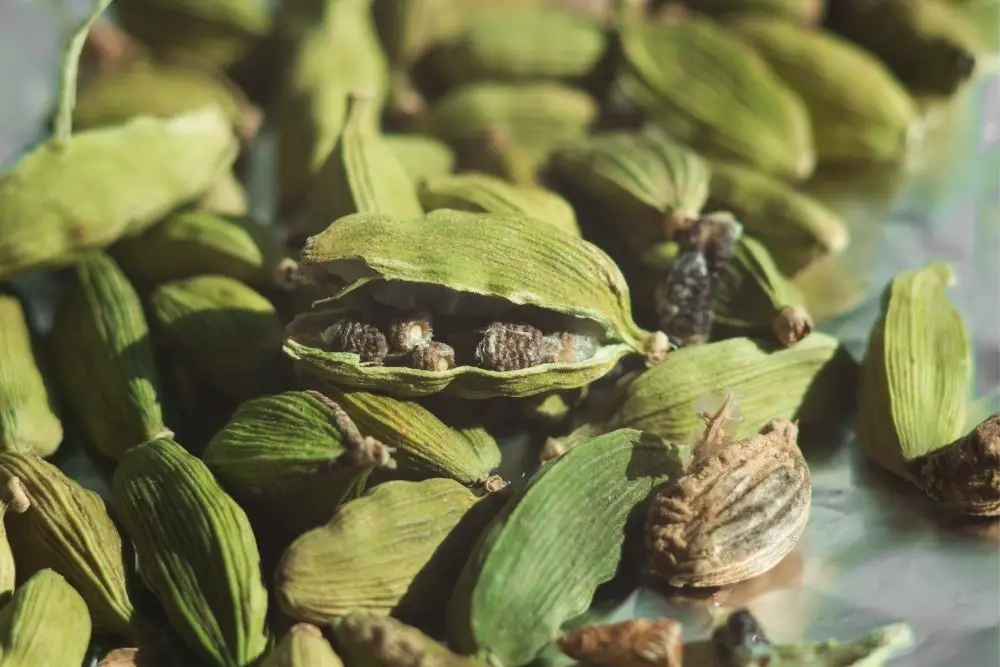
Green cardamom tastes like an “earthy ginger”: sweet, zesty, spicy, with subtle hints of citrus. When green cardamom is used in recipes, you can use both the pods and the seeds for flavoring. Just be sure to discard the inedible fibrous green cardamom pods before serving. You can also grind the seeds in a coffee grinder or with a mortar and pestle before adding them to your recipe.
You’ll find green cardamom in chicken and red meat dishes, curries, stews, and desserts, such as Kulfi (an Indian dessert consisting of frozen custard), mulled wine, chai, pistachio-inspired desserts, and sugar cookies. Green cardamom also pairs well with other warming spices like nutmeg and cinnamon. While it’s certainly pungent, green cardamom is more delicate than black cardamom, which has an intense, smoky flavor.
What Does Black Cardamom Taste Like?
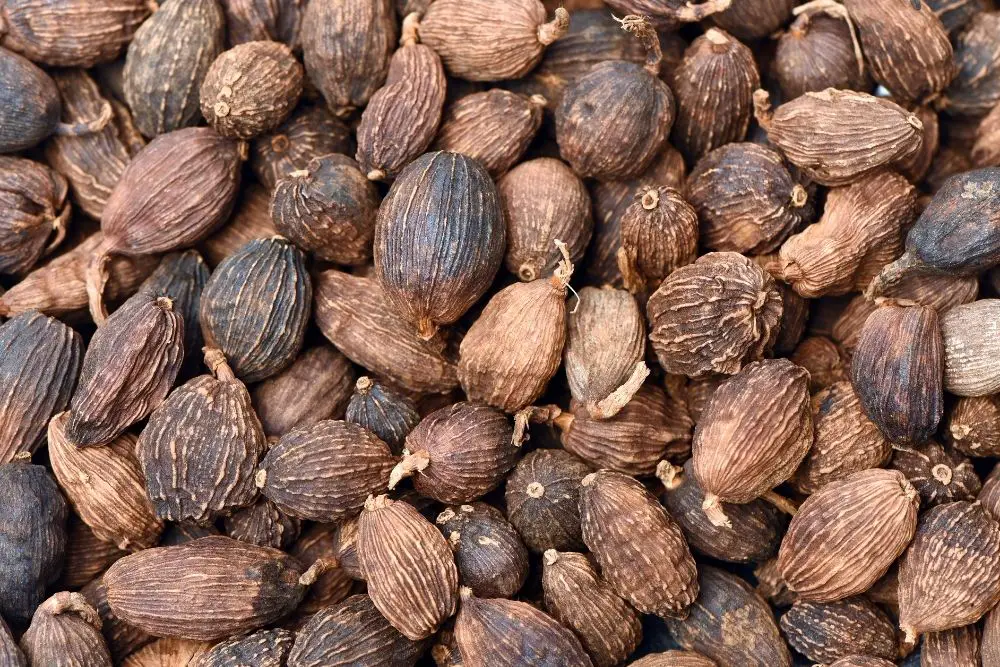
Black cardamom pods have smoky undertones with a sharp menthol flavor, which is why you’ll mostly find this variety in savory dishes such as stews, curries, marinades, and spice blends like garam masala—and not so much in sweet dishes. Due to its intense taste, it’s not as versatile as green cardamom for different types of recipes.
Since black cardamom is so pungent, it’s recommended to balance it out in recipes with warming spices like cinnamon, chilis, Sichuan peppercorns, cloves, allspice, or ginger.
What Does White Cardamom Taste Like?
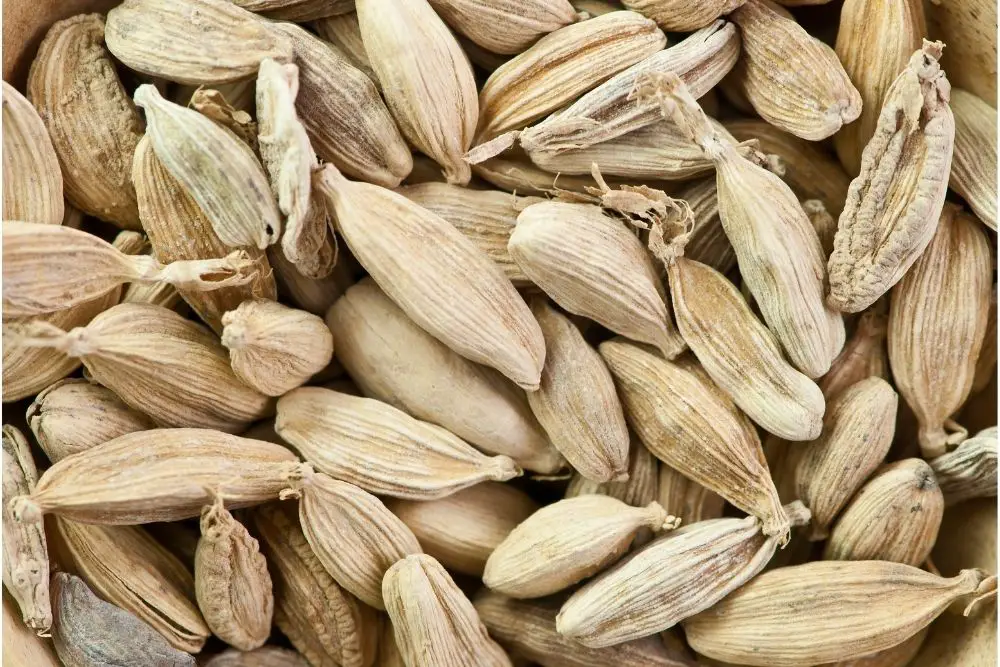
White cardamom is just a green cardamom that’s been bleached to tone down its flavor. So, it has the same flavor profile as green cardamom but is milder and more delicate. It can be used in any dishes you’d use green cardamom in, including desserts, meat dishes, and chai.
What’s the Best Cardamom Substitute?
Some spices can be hard to mimic and find accurate substitutes for. Luckily, with cardamom’s warming, sweet, zesty, and spicy flavor profile, a few aromatics with similar properties can step in and do the trick.
1. Cinnamon

Cinnamon is widely regarded as the best stand-alone cardamom substitute. It’s warming, slightly citrusy, and sweet with hints of spice.
How to substitute: One teaspoon of ground cardamom = one teaspoon of ground cinnamon.
2. Nutmeg
If you don’t have cinnamon, nutmeg is the next best stand-alone cardamom substitute. It’s warm and slightly sweet, with a hint of nutty, woody flavor. While it’s not an exact match to cardamom, it embodies the sweet and warming qualities that can help you achieve a similar flavor in sweet and savory recipes.
How to substitute: One teaspoon of ground cardamom = one teaspoon of ground nutmeg.
3. Nutmeg and Cinnamon
Since cardamom has a lot of depth, using both nutmeg and cinnamon together can help achieve a little more complex flavor. If you have both spices on hand, you may want to use equal parts of both, rather than nutmeg or cinnamon on its own.
How to substitute: One teaspoon of ground cardamom = ½ teaspoon of ground cinnamon + ½ teaspoon of ground nutmeg.
4. Ground Cloves and Cinnamon or Ground Cloves and Nutmeg
If you’re looking for more intensity, combining cloves with cinnamon or nutmeg is another great cardamom substitute. Cloves bring the intense, warming, ashy, and pungent properties of cardamom, while cinnamon or nutmeg step in to bring extra warmth and sweetness.
How to substitute: One teaspoon of ground cardamom = ½ teaspoon of ground cloves + ½ teaspoon of ground cinnamon or nutmeg
5. Cinnamon and Ginger
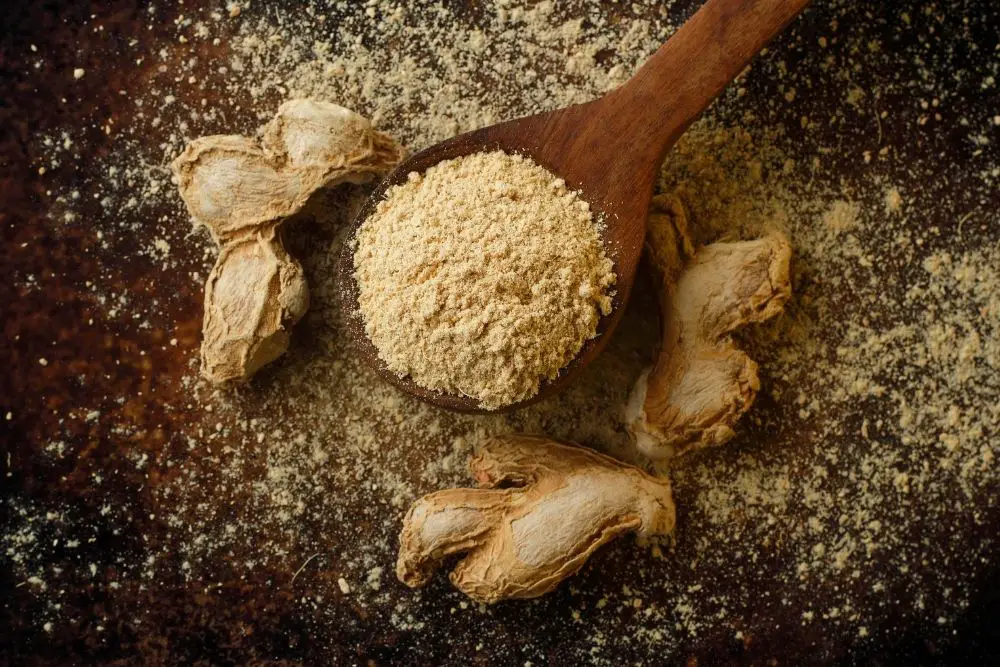
The warmth and sweetness of cinnamon, combined with the sharp, spicy, peppery, sweet taste of ginger, create a flavor profile similar to that of cardamom.
How to substitute: One teaspoon of ground cardamom = ½ teaspoon of ground cinnamon + ½ teaspoon of ground ginger.
6. Allspice
Allspice is fragrant, sharp, and slightly fruity, with the flavor of black pepper, cloves, nutmeg, and cinnamon. It is milder than cardamom, but it still works well in recipes as a substitute. To give the allspice substitute a little more complexity, you could experiment by combining it with ½ or ¼ teaspoons of cinnamon, ginger, or cloves.
How to substitute: One teaspoon of ground cardamom = one teaspoon of ground allspice
(Optional to add ¼ teaspoons of other suggested spices to taste).
7. Apple Pie Spice
Cardamom is one of the ingredients in apple pie spice, along with ground cinnamon, ginger, and nutmeg. So, if you’re really in a pinch (or especially if you’re making a dessert), you can use apple pie spice in place of cardamom. It will just be milder and slightly sweeter.
How to substitute: One teaspoon of ground cardamom = one teaspoon of apple pie spice.
8. Cumin and Coriander
For those savory recipes like Indian stews, curries, soups, and meat dishes, cumin and coriander can achieve a similar earthy, warming profile to cardamom. You can use either ground cumin and coriander or cumin and coriander seeds.
How to substitute: One teaspoon of ground cardamom = ½ teaspoon ground cumin + ½ teaspoon ground coriander.
The Takeaway
Cardamom is a unique, sharp, and pungent spice that’s used in sweet and savory recipes, including desserts, baking, meat dishes, stews, and curries. It comes in three different varieties: green, black, and white. Green cardamom (while still pungent) is milder and more delicate than black cardamom, which has a sharp, ashy, menthol flavor.
If your recipe calls for green cardamom, the best cardamom substitute is equal parts cinnamon, equal parts nutmeg, or ½ teaspoon of cinnamon and ½ teaspoon of nutmeg. You could also add cloves to cinnamon or nutmeg for more intensity (which can mimic similar properties of black cardamom but is still mild enough to use in dessert recipes).
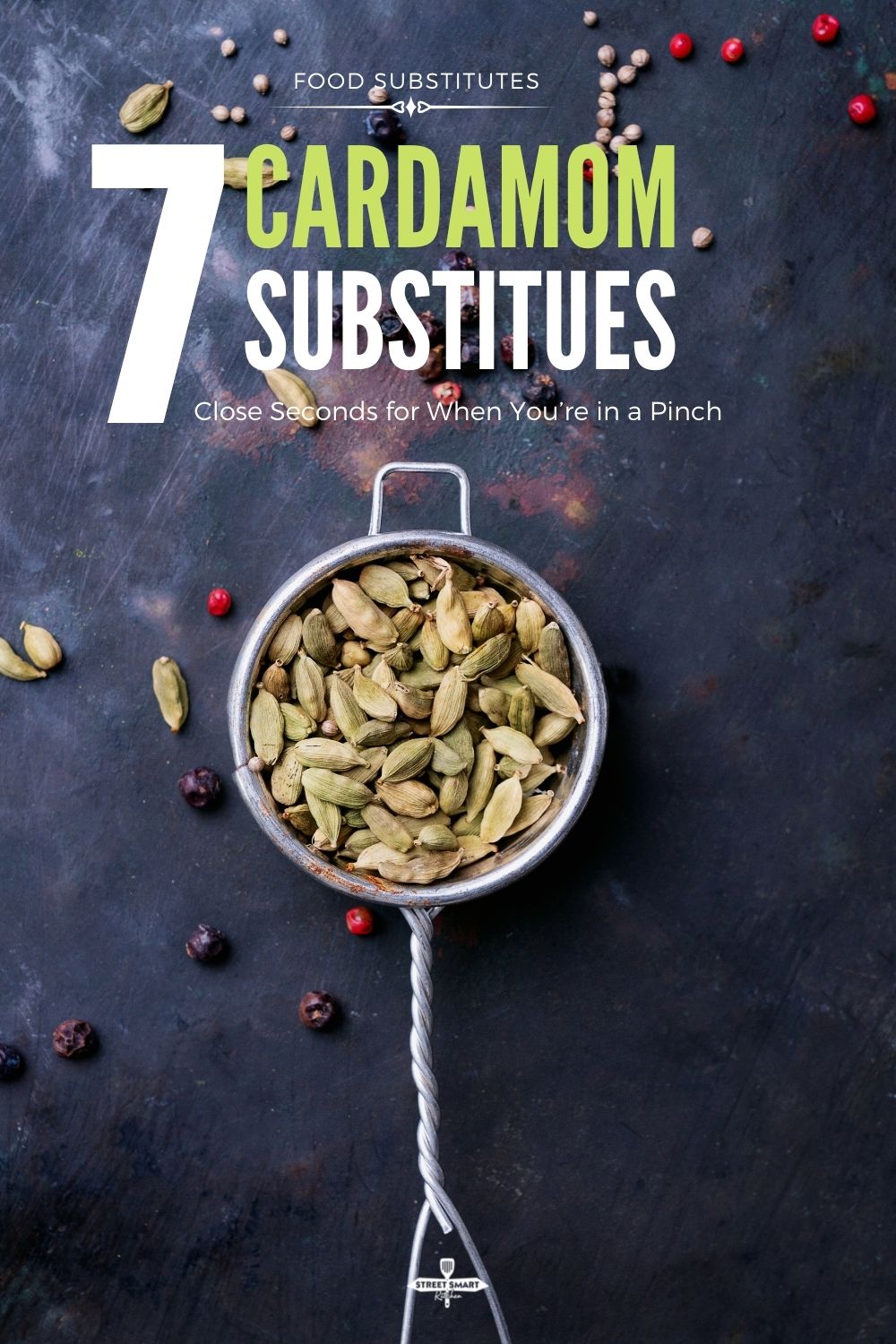
About the Author
Sharon Chen is an Integrative Nutrition Health Coach and author of the Complete Sous Vide Cookbook. She believes food not only brings healing but also connection. As the creator of StreetSmart Kitchen, she aims to make meal prep easier than ever and help you find balance, ease, joy, and simplicity in the kitchen as you improve your well-being.


